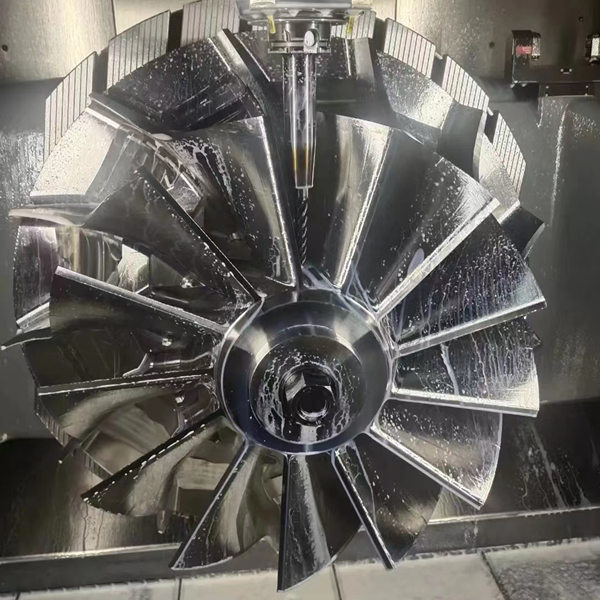The Art and Science of Impeller Machining: A Guide for Engineers
From aerospace to HVAC, impellers are the workhorses of fluid dynamics - converting rotational energy into pressure and flow.
This blog discusses various aspects of impeller manufacturing, answers your questions about the difference between an impeller and a propeller, and discusses advanced design
approaches in search of the mother of all efficiencies.

1. How Are Impellers Manufactured?
Impeller manufacturing takes a mix of advanced engineering drawings and precision machining. Here is a snapshot view of the process:
Design & Simulation
Modern impeller manufacturing starts with computational fluid dynamics (CFD) simulations to define the blade geometry, pressure ratios,
and flow paths.
Other aspects such as inlet/exit angles and bias angles may be set in advance and optimized using response surface methodology (RSM)
based on efficiency and torque .
Material Determining
Common materials for impellers include alloy aluminum, stainless steels, and engineering resins with superior mechanical performance.
In the case of centrifugal compressors for fuel cell vehicles, lightweight and durable alloys are preferred due to energy loss concerns .
Preform Production
The preform is usually manufactured through a casting process (often a fine casting process) to create a near-net shape. As an added measure
of assurance, manufacturing process parameters require forging to critical sections to improve structural integrity. In the case of resin-based impellers
(ex. centrifugal blowers), more often, than not, laser welding is used to attach the hollow blades to a rotator hub while under axial compression .
CNC Machining
Complex blade profiles with micron tolerances are processed on multi-axis CNC machines.Falcon CNC is a 5-axis machining service to provide
smooth machined-surfaces on the impellers used to reduce turbulence.
Finishing & Testing
After machining is complete, the received parts may undergo balancing, polishing, and coatings like nickel plating. The impeller's operational
performance can be verified by performing hydrodynamic testing in a lab setting .
2. Impeller vs. Propeller: The Important Differences
Although both an impeller and a propeller have rotating blades, they are different in their application functions and designs:
Function:
Impeller is meant to move fluids through an assembly (ex. pumps and compressors) by causing the fluid to accelerate either radially (outwards
from the center) or axially (away from the direction of the blade's rotation) .
A propeller is designed to create thrust to move a vehicle (ship, drone) through a fluid (air or water) .
Design:
Impellers usually have blades that are enclosed to create a directed flow of the fluid. Propellers typically have open blades designed for maximum
thrust due to decreased drag when moving through a fluid .
Propellers build thrust for few different reasons than an impeller would achieve its pressure rise for an application. Propellers would look at the
thrust to power ratio for efficiency An impeller can potentially deliver the fluid at a required pressure based on the design which is essential for stability
of flow and flow performance over time.
Applications:
Impellers: turbochargers, fuel cell compressors, industrial pumps.
Propellers: outboard motors for vessels, aircraft, wind turbines for generation of power.
3. What constitutes an efficient impeller design?
An efficient design of the blade component comes down to compromising on aerodynamic performance, resilient material performance, and ability of
manufacturing the blades:
Blade Geometry Optimization
The exit angles and bias angles can be crucial to the torque ratios and how efficient it is at a peak performance. Larger angles of the exit would maximize
the transfer energy efficiency which is especially important to an automotive torque converter. In the same sense, /the blade design has been created
behind the scenes using CFD which helps prevent turbulence or cavitation potential or risk.
Material Innovation
A thin walled, resilient, high strength alloy materials will create an optimum impeller blade design due to minimized weight and minimized material
resistance to pressure. With the emerging use of additive manufacturing one could use new designs that accelerate the use of unique geometry to
pique the interest of owners.
Surface Finish
When the impeller is polished it reduces friction losses. Coatings are available and DLC (diamond-like carbon) for example are further resistant to
wear and corrosion.
Operational Flexibility
The impeller that is most ideal is going to be the most efficient across loads. For example, it is easy for optimized design of centrifugal compressor
impellers to have flat performance characteristics or a flat performance curve across operational variations in load.

4. Industry Applications & Falcon CNC Capabilities
Whether it is a fuel cell compressor, an automotive torque converter or thrust propulsion in a vessel (marine) impellers usually constitute the ideal design.
Falcon CNC Machining can
offer our customers:
-5 axis precision machining for time sensitive work to complete more complex blade geometry work for the aerospace or energy industry.
-One Stop Shop for end to end work- from CFD to post processing.
-Machining experience with common material types such as stainless steels, titanium, and engineered polymers.
Why choose Falcon CNC?
We have over a decade of experience servicing many Fortune 500 customers.
We have ISO certified quality testing.
To assure what you get met engineering specifications as it applies to ASME/API did, we will conduct thorough testing.
We can support rapid prototyping measures to expedite R&D cycles our advanced CNC and EDM capabilities.
Are you ready to optimize your impeller performance? - Contact Falcon CNC Machining for a free consultation on the design.